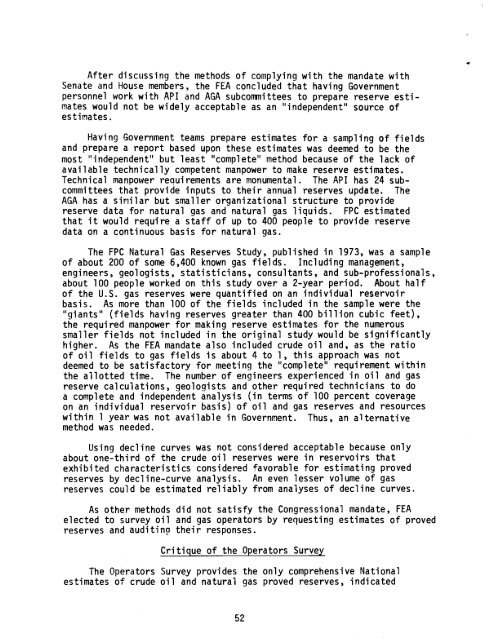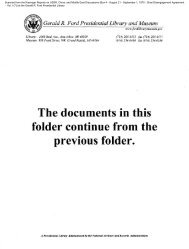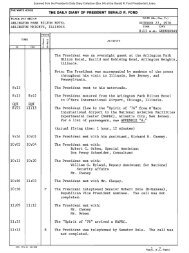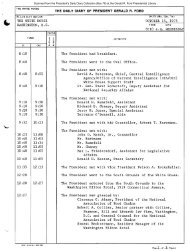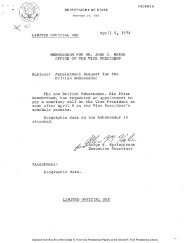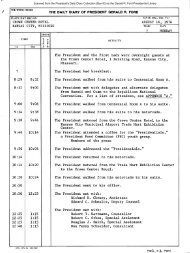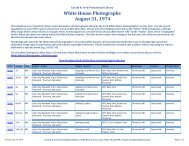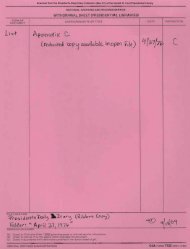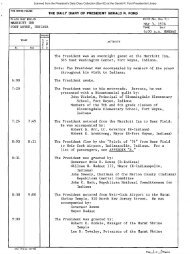October 31, 1975 - Gerald R. Ford Presidential Library and Museum
October 31, 1975 - Gerald R. Ford Presidential Library and Museum
October 31, 1975 - Gerald R. Ford Presidential Library and Museum
Create successful ePaper yourself
Turn your PDF publications into a flip-book with our unique Google optimized e-Paper software.
After discussing the methods of complying with the m<strong>and</strong>ate with<br />
Senate <strong>and</strong> House members, the FEA concluded that having Government<br />
personnel work with API <strong>and</strong> AGA subcommittees to prepare reserve estimates<br />
would not be widely acceptable as an lIindependent li source of<br />
estimates.<br />
Hav"ing Government teams prepare estimates for a sampling of fields<br />
<strong>and</strong> prepare a report based upon these estimates was deemed to be the<br />
most lIindependentli but least IIcompleteli method because of the lack of<br />
available technically competent manpower to make reserve estimates.<br />
Technical manpm'ler requirements are monumental. The API has 24 subcommittees<br />
that provide inputs to their annual reserves update. The<br />
AGA has a siMilar but smaller organizational structure to provide<br />
reserve data for natural gas <strong>and</strong> natural gas liquids. FPC estimated<br />
that it would require a staff of up to 400 people to provide reserve<br />
data on a continuous basis for natural gas.<br />
The FPC Natural Gas Reserves Study, published in 1973, was a sample<br />
of about 200 of some 6,400 known gas fields. Including management,<br />
engineers, geologists, statisticians, consultants, <strong>and</strong> sub-professionals,<br />
about 100 people worked on this study over a 2-year period. About half<br />
of the U.S. gas reserves were quantified on an individual reservoir<br />
basis. As more than 100 of the fields included in the sample were the<br />
IIgiantsli (fields having reserves greater than 400 billion cubic feet),<br />
the required manpower for making reserve estimates for the numerous<br />
smaller fields not included in the original study would be significantly<br />
higher. As the FEA m<strong>and</strong>ate also included crude oil <strong>and</strong>, as the ratio<br />
of oil fields to gas fields is about 4 to 1, this approach was not<br />
deemed to be satisfactory for meeting the IIcomplete li requirement within<br />
the allotted time. The number of engineers experienced in oil <strong>and</strong> gas<br />
reserve calculations, geologists <strong>and</strong> other required technicians to do<br />
a complete <strong>and</strong> independent analysis (in terms of 100 percent coverage<br />
on an individual reservoir basis) of oil <strong>and</strong> gas reserves <strong>and</strong> resources<br />
within 1 year was not available in Government. Thus, an alternative<br />
method was needed.<br />
Using decline curves was not considered acceptable because only<br />
about one-third of the crude oil reserves were in reservoirs that<br />
exhibited characteristics considered favorable for estimating proved<br />
reserves by decline-curve analysis. An even lesser volume of gas<br />
reserves could be estimated reliably from analyses of decline curves.<br />
As other methods did not satisfy the Congressional m<strong>and</strong>ate, FEA<br />
elected to survey oil <strong>and</strong> gas operators by requesting estimates of proved<br />
reserves <strong>and</strong> auditing their responses.<br />
Critique of the Operators Survey<br />
The Operators Survey provides the only comprehensive National<br />
estimates of crude oil <strong>and</strong> natural gas proved reserves, indicated<br />
52<br />
..


